Text
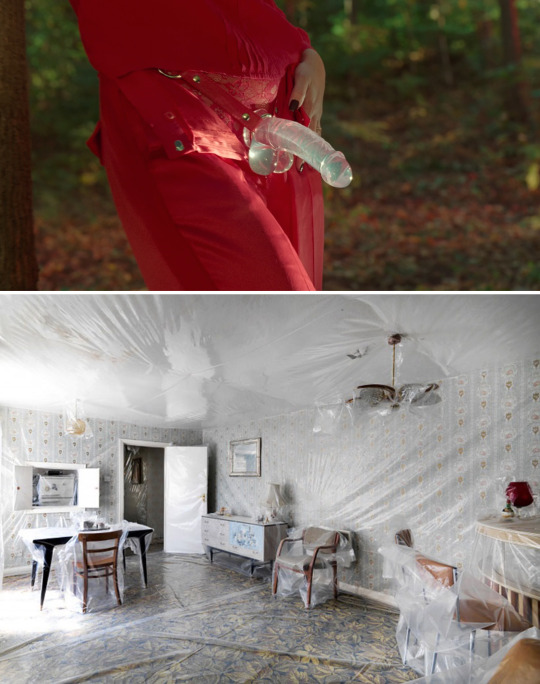
Top, screen capture from Babysitter, directed by Monia Chokri, 2022. Bottom, Iain Baxter&, Rebeccas bagged place: a plastic wrapped flat, 1966, photographed by Marcus J. Leith. Via.
Rebecca Levy lived in the apartment directly above the Raven Row Gallery in London. when she passed away, the contents of her flat were donated to the gallery, leaving behind intimate possessions and furniture pieces, which narrate her adventures and experiences.
Canadian contemporary artist Iain Baxter& utilized the abandoned space for his work ‘Rebecca’s bagged place’. permitted by the gallery to use the location, which typically remains inaccessible to the public, the artist wrapped each object and surface — from the patterned wallpaper, to faux flower arrangements and refrigerator magnets — in sheets of transparent plastic, preserving the items and their distinct arrangement before levy passed away. Via.
--
The process is essentially private, because it is so much concerned with intimacies which were not, and could not be, shared with others when the deceased partner was alive. The work of mourning is, by its very nature, something that takes place in the watches of the night and in the solitary recesses of the individual mind.
Mourning is one example of a long drawn out mental process leading to an eventual change of attitude. Instead of regarding life as necessarily bound up with, or even constituted by, the existence of an intimate relationship with the deceased person, the mourner comes to see matter differently. The mourner may or may not form new, intimate ties; but whether he or she does so or not, the mourner usually comes to realize that the significance of life is not entirely constituted by personal relationships; that the life of a person without intimate relationships also has meaning.
Anthony Storr, from Solitude: A Return to the Self, 1988. Via.
See also, Excerpt: Gregor Schneider, Die Familie Schneider (2004)
0 notes
Text
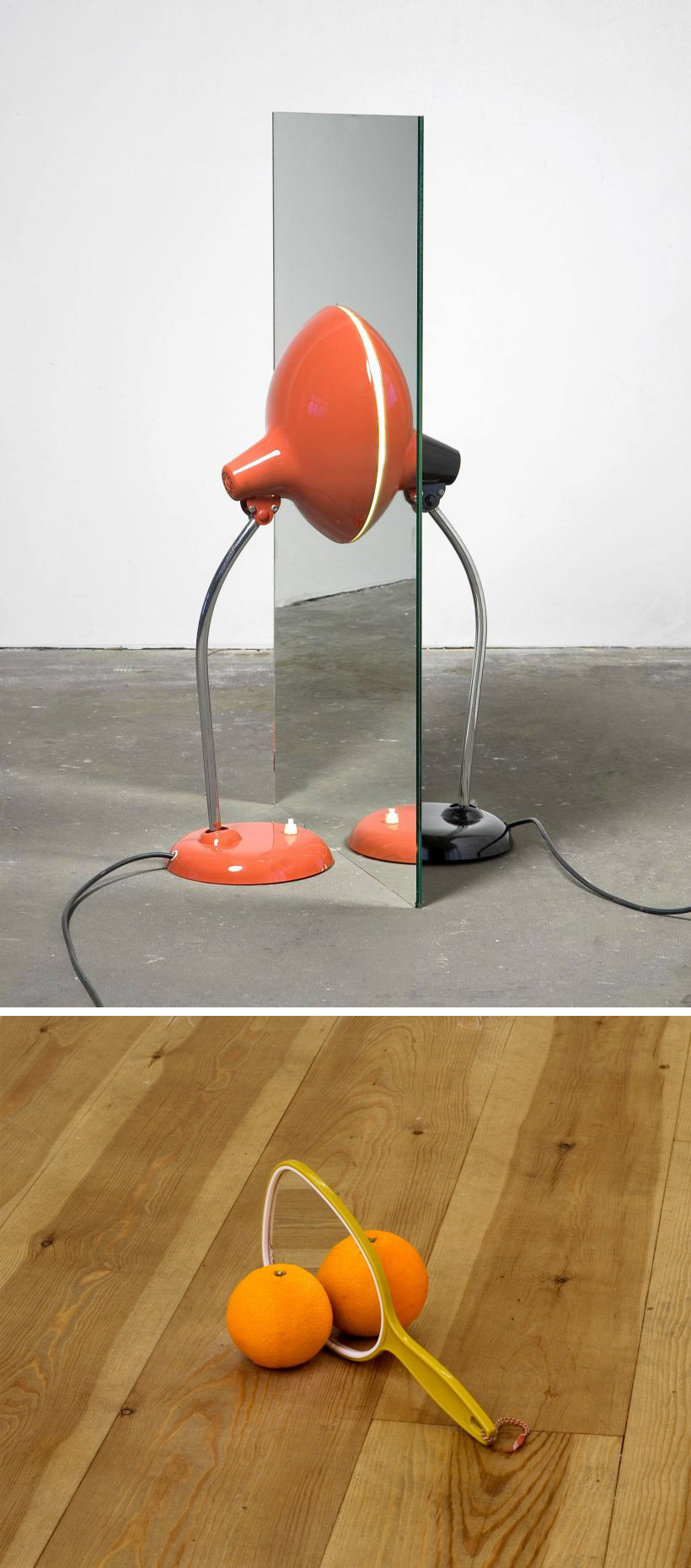
Top, Alicja Kwade, Parallelwelt (rot/schwarz), 2009, Lamps and mirror, 83 × 45 × 45 cm. Via. Bottom, Marijn van Kreij, Untitled, 2008, Orange, mirror and fake orange (acrylic, foam and tape), 13 x 16 x 30 cm. Via.
--
The luminous images of the mystics reveal a full and luminous extra consciousness on which shadows or nothingness have no hold. This is why the feeling, the consciousness of ‘being’ is expressed in images of light, and it is also why light, presence, plenitude are synonyms of ‘spirituality.’ Initiation means illumination, the dispersion of shadows, nothingness held off. Thus the plentitude that I felt was perhaps a little like mystic plenitude. It began with the feeling that space was emptying itself of its material heaviness, which explains the euphoric sense of relief that I felt. Notions were freed of their content. Objects became transparent, permeable; they were no longer obstacles and it seemed as if one could pass through them. It was as if my mind could move freely, as if there were no resistance to its movement. Thus my mind could find its center again, reunited, reassembled out of the matrixes and limits withing which it had been dispersed. And it was from this moment on that the feeling of plenitude took hold.
Eugène Ionesco, from Present Past / Past Present, translated by Helen R. Lane (Da Capo Press, 1998). Via.
--
The woman dies. She dies to provide a plot twist. She dies to develop the narrative. She dies for cathartic effect. She dies because no one could think of what else to do with her. Dies because there weren’t any better story ideas around. Dies because her death was the very best idea that anyone could come up with ... And so, the woman dies. The woman dies so the man can be sad about it. The woman dies so the man can suffer. She dies to give him a destiny. Dies so he can fall to the dark side. Dies so he can lament her death. As he stands there, brimming with grief, brimming with life, the woman lies there in silence. The woman dies for him. We watch it happen. We read about it happening. We come to know it well.
Aoko Matsuda, from The Woman Dies, for GRANTA, translated by Polly Barton, November 2018. Via.
--
Once a week, Sun Kai has a video call with his mother. He opens up about work, the pressures he faces as a middle-aged man, and thoughts that he doesn’t even discuss with his wife. His mother will occasionally make a comment, like telling him to take care of himself—he’s her only child. But mostly, she just listens.
That’s because Sun’s mother died five years ago. And the person he’s talking to isn’t actually a person, but a digital replica he made of her—a moving image that can conduct basic conversations. They’ve been talking for a few years now.
After she died of a sudden illness in 2019, Sun wanted to find a way to keep their connection alive. So he turned to a team at Silicon Intelligence, an AI company based in Nanjing, China, that he cofounded in 2017. He provided them with a photo of her and some audio clips from their WeChat conversations. While the company was mostly focused on audio generation, the staff spent four months researching synthetic tools and generated an avatar with the data Sun provided. Then he was able to see and talk to a digital version of his mom via an app on his phone.
Zeyi Yang, from Deepfakes of your dead loved ones are a booming Chinese business - People are seeking help from AI-generated avatars to process their grief after a family member passes away, for MIT Technology Review, May 7, 2024.
3 notes
·
View notes
Text

Top, screen captures from various webcams in Austria, Italy and Germany showing Northern Lights, May 10, 2024. Via Nahel Belgherze. Bottom, Clarence John Laughlin, Woman Attacked by a Cloud (Descent of a Cloud), 1941, Silver gelatin print. Via.
--
Throughout The Mystery Guest, Boullier certainly does not sound like a man in top form, and his willingness to make himself appear buffoonish saves the book from being an agonizing exercise in flowery self-pity. In the kind of perfectly ironic detail that could only come directly from real life, he decides to distinguish himself by spending more than a month’s rent on a bottle of 1964 Margaux, only to learn that as part of her artistic practice, Calle keeps all of her birthday gifts in storage in their original wrapping. (If he really had been Jesus Christ, a bottle of Evian would have sufficed.) At the party, Boullier talks shit, and crosses the line between anonymous, iconoclastic interloper and garden-variety wine-drunk jerk. The prose is breathless, sometimes drunk seeming itself, and there is something realistic, even touching, about its perpetual ricocheting between hope and despair, often within the span of a single sentence. It is a tightly written portrait of the artist as a young(ish) mess, and its ingenuity lies in its positioning of the “mystery guest” as an idealized state that exists in diametric opposition to the thoroughly unmysterious position of the ex-lover. Familiarity breeds contempt, and it can also hasten breakups. If Boullier can make himself unknowable enough again, perhaps he can represent not only Calle’s future but also that of the woman who once loved him.
His problem—much to our delight, since this dilemma is what lends the book its jittery edge—is that he cannot be mysterious to save his life. In the final pages of the book, Boullier and Sophie Calle meet again some years later, and despite his misogynistic flinching at her age (“in five years she’d be fifty-five, and then sixty, and that vision was hopeless and implacable”), it becomes clear that they are twin souls, if not necessarily cut out to be lifelong soulmates: obsessed with fate, and to some degree with themselves, they have an eye for the kind of minor details that make for terrific fiction, even when they are supposedly recording facts. For a time after this meeting, they were lovers, until Boullier eventually sent her a meandering, self-important breakup email. Calle—in a move that a man so obsessed with signs surely ought to have foreseen—anonymized him as “X” and turned the email into her 2007 entry for the Venice Biennale, Take Care of Yourself, asking women from 107 different professions, from a cruciverbalist to a Talmudic scholar, to interpret his words. If dumping a writer is a risky move, dumping an artist might be more dangerous still: like an invading force, they tend to recruit collaborators.
Philippa Snow, from We Are Never Ever Getting Back Together - Two French authors’ dueling narratives of heartbreak, for Bookforum, Spring 2024.
7 notes
·
View notes
Text
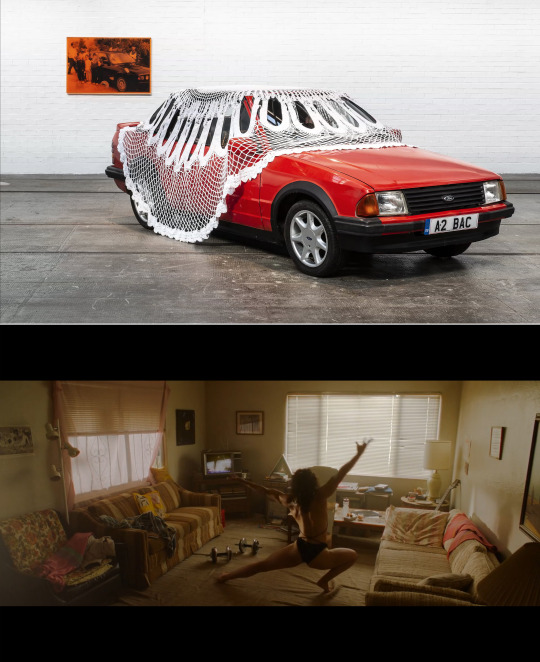
Top, Jasleen Kaur, Sociomobile, 2023, from the solo exhibition Alter Altar at Tramway, Glasgow, March 31 - October 8, 2023. Photograph by Keith Hunter. Bottom, screen capture from Love Lies Bleeding, directed by Rose Glass, 2024.
The sense of the inherited and the discovered, of passed-down ways of living and new cultural understandings, continues with Sociomobile—a red Ford Mk3 Escort Cabriolet XR3i covered with an oversize white cotton doily. The vehicle, Kaur says, represents her dad’s “first car and migrant desires,” while the crocheted doily makes reference to empire, the cotton trade, and the textile mills in Britain where many people from the Indian subcontinent came to work. A car sound system playing short blasts of music ranging from Nusrat Fateh Ali Khan to ’90s rave seems to signal a generational shift while giving a familial nod to Kaur’s older brother and the home-built speakers he used to make. Via.
--
There is this meme/t-shirt “Dead Inside.” I often have to think of that ironic logo, designed with the same “Intel Inside” font. What happens when we can no longer see the end of the hockey stick because of its never-ending exponential growth? Study the roll-out of video-on-demand services in Africa, smartphone use in India, growth of data centres in China, and e-commerce in Brazil. All of this runs on internet protocols, yet we no longer associate it with ‘the internet’. What you’re referring to I would relate to ‘the internet’ as an intellectual-cultural project. A TGP, indeed, but nonetheless one with strategic moments of accelerated concept development, decision making and roll-out. One could define my generation as one that thought—mistakenly or not—networked hackers, artists and designers were able to steer the direction in which this medium potentially would develop. After all, operating systems, chip designs, and interfaces are all built on concepts that are turned into code. This code then structures the way information and the social are organized. In part, this is happening on the design side, in part also on the side of reviewing and critique—and ultimately (but rarely) culminating in the development of alternatives.
What has died is the collective imagination to design and shape another internet. I have dealt with this in my essay Extinction Internet. Platform dependency became real: who can afford to leave Insta, TikTok, X and Facebook, say no to all the Google links they are offered to open, having to politely point at alternatives like Jitsi each time someone asks you to join a Zoom or Team session. Early defeats of Linux and similar open-source and free software alternatives showed the way. Alternatives remained strictly inside the tech scene of geeks. The mental price we pay for this, getting stuck on the platform, and not able to move on, is high. It is not just a tragic anti-trust consumer story.
The techno-regression I am describing here is, of course, related to a wider failure of progressive movements to create viable alternatives. The little energy that was left has been wasted on sectarian identity politics—played out on social media platforms that should have been deserted a decade ago. Not a single generation stood up against Zuckerberg. Again, what’s dead is the debate on how the medium should be shaped next. Its élan vital has dissipated and young people remain hooked, this time on Tik-Tok, an even worse clone of Instagram. This is why so many of the brightest minds have left the internet context and joined the speculative debates around machine learning (mind you, without exiling social media), getting lost in metaphysical entities such as ‘intelligence’ and ‘artificiality’– leaving behind all the unresolved issues of the zombie space called the internet. In the meanwhile, ‘media literacy’ is dropping and the masses remain clueless about how to deal with email fraud, fake news and deep fakes.
Geert Lovink interviewed by by Ingrid Luquet-Gad, April 22, 2024. Via.
0 notes
Text

Top, page from Raymond Buckland, Solitary Seance: How You Can Talk with Spirits on Your Own, 2011. Via. Bottom, photograph via NASA, Toroid inflatable station concept during testing, 1961. Via. More.
Using the pendulum is known as radiesthesia—also rhabdomancy, or cleidomancy. One of the best-known uses of the pendulum is in dowsing, in finding where to drill for water. But it is also used for many other things, not least of all for communicating with spirit.
Unlike many other early space station concepts, this design actually made it out of the concept phase and into production, though no models were ever flown. This particular station was 30-feet and expandable. It was designed to be taken to outer space in a small package and then inflate in orbit. The station could, in theory, have been big enough for 1 to 2 people to use for a long period of time. A similar 24 foot station was built by the Goodyear Aircraft Corporation for NASA test use. The concept of space inflatables was revived in the 1990s. Via Wikipedia.
--
‘If an artist who conceived a work says that it is unfinished and should not be exhibited, it isn’t – and shouldn’t be.’ The court felt differently: ‘When an artist makes a decision to begin work on a piece of art and handles the process of creation long-distance via e-mail, using someone else’s property, someone else’s materials, someone else’s money, someone else’s staff, and, to a significant extent, someone else’s suggestions regarding the details of fabrication – with no enforceable written or oral contract defining the parties’ relationship – and that artist becomes unhappy part-way through the project and abandons it,’ wrote the presiding judge, Michael Ponsor, ‘then nothing in the Visual Artists Rights Act or elsewhere in the Copyright Act gives that artist the right to dictate what that “someone else” does with what he has left behind, so long as the remnant is not explicitly labeled as the artist’s work.’ (...)
Essentially a horrific readymade, Barca Nostra sunk in April 2015 between Libya and Lampedusa with an estimated 1,000 migrants onboard, of whom 28 survived. The Italian government recovered the wreck in 2016 and moved it to a base in Sicily before it was placed under the care of the Augusta municipality, a landing site for Operation Mare Nostrum, Italy’s response to the Mediterranean migrant crisis. Mare Nostrum, or ‘Our Sea’, cost the Italian government a reported £7 million per month, and ensured safe passage for over 100,000 people within a year of its launch in October 2013. But after Italy appealed for assistance, EU states criticised the operation for encouraging people to risk the sea crossing, so EU agency Frontex replaced Mare Nostrum with Operation Triton in 2014, with a slashed budget and focus on border security.
Effectively a policy of nonassistance, as Forensic Oceanography concluded in their 2016 report Death by Rescue: The Lethal Effects of Non-Assistance at Sea, Triton created a situation where commercial ships were increasingly called into rescue missions they weren’t suited to conduct – such was the case with the sinking of Barca Nostra in 2015, they found. That year, European Parliament president Martin Schulz called for ‘burden sharing’ based on the fact that five out of 28 EU member states were taking in 50 percent of refugees to Europe at the time. Yet no effective cooperation manifested. Neither in creating humanitarian responses to a global crisis, nor in mediating the ultraright sentiments and movements that rose as a result – as demonstrated in 2018, when Italy’s far-right interior minister, Matteo Salvini, launched a campaign to block search-and-rescue vessels from docking in Italian ports, and drafted a hardline anti-migrant bill adopted by the Italian government.
It was within this desperate context that Barca Nostra was brought to the Venice Biennale – in cooperation with Augusta’s municipal council and Comitato 18 Aprile, which lobbied against government plans to scrap the ship – with Büchel covering transportation costs. Presented with little information – not for the lulz, it seems, but out of contempt for a wilful ignorance – the vessel’s arrival was lambasted as ‘tasteless’ by those at the vernissage, seemingly more concerned with the insult of its presence – and those taking selfies with it, like a Martha Rosler collage come to life – than discussing the exclusionary policies that brought it into being. (Granted, as curator Alexandra Stock wrote in a scathing takedown, ‘The optics [were] bad because Büchel set it up that way’.) While the stunt drew international attention – including responses from Salvini himself, countering the idea that the Venice Biennale is an ineffective stage for protest – it also revealed the limits of internationalism, whether in the artworld or the world at large.
Stephanie Bailey, from Christoph Büchel: Fear and Loathing in Venice, for Art Review, April 14, 2024.
11 notes
·
View notes
Text


Left, screen captures from L'Arbre, le Maire et la Médiathèque, directed by Éric Rohmer, 1993. Via. Right, screen captures from El tango del viudo y su espejo deformante, directed by Raoul Ruiz & Valeria Sarmiento, 2020. Via.
--
We use our phones to take something that seems rare or singular and make it into something extremely ordinary. The phone allows us to subordinate the event to our desire to belong. The more useless the photo is, the more it confirms that we are on the inside of a shared vision, and not looking at things the wrong way. (...)
But it still seems deeply, pointedly irrational to photograph an eclipse. It is an effort to photograph a ghost, a rumor. Part of me wants to argue that there is some sort of atavistic counter-mimesis at play in photographing an eclipse, a desire to “save” the sun as it becomes obscured and thereby express a kind of delusional mastery over cosmological processes. Photographing an eclipse could be seen as a ritual act of supplication, a gesture to placate the indifferent gods that set the skies spinning. Once photography seemed magical because it could passively inscribe reality and reproduce it; now we demand a different magic from it, it must do something else to still seem powerful. Photos cease to be documents and become prayers.
A picture of the eclipse places the photographer paradoxically in the time before photography, not because of what it depicts but because it is a souvenir of that momentary intimation of the era of myth, when reality and experience were supposedly untroubled by mediation and everyone lived in the shared, immediate presence of being. It doesn’t matter that that feeling doesn’t look like anything, that it is unphotographable in its essence. The eclipse photo is a picture of being afraid of the dark.
Rob Horning, from Images of unphotographability, April 12, 2024.
2 notes
·
View notes
Text
When Bryan first appeared on screen, the crowd clapped and cheered — thrilled to see him and get the opportunity to hear him speak. But a stunned silence fell across the room when Bryan revealed his plans, telling the audience: ‘I’m wanting to build a “don’t die” nation-state. (...) Citizens would gain healthcare access via their ‘pooled resources’ — like health insurance — and via specialist contracts with providers. Citizens would also likely need to follow a version of the grueling ‘Blueprint’ plan – with 5am wake ups, early morning hour-long work outs and a diet that never exceeds 2,250 calories. Items such as pizza and donuts would also be made no-go products for residents. Bryan added: ‘Anything I do that increases death I am label an act of violence. ‘So the act of eating pizza, donuts, Chick-fil-A and drinking is an act of violence in itself.’
Luke Andrews, from Millionaire biohacker Bryan Johnson (who already has a cult-like following) plans to start his own NATION for anti-agers... where pizza, donuts and alcohol could be illegal, for The Daily Mail, March 19, 2024.
0 notes
Text

Fette Sans, Untitled (If I can’t sleep at night is it because I am awake [redacted] with Dr Younes), 2017.
Performance. Part of my five-month-long project at Hotel Zoo Berlin. I invite a friend to pass as my psychotherapist in New York—Dr Younes—and I organize two public sessions of 90 min which I also record. The truthful nature of our relationship is kept undisclosed to the attendees. I wear tie-dye leggings, a pink top, a muslin kimono offered by BIEST, and a light hair color bob wig. I have taken off my glasses and I do not wear contact lenses. I am sitting on the bed with headphones and Dr Younes can also be heard on the speakers. The only interdict I give him is to not ask about the sessions themselves, anything else can be discussed. We do not rehearse.
2 notes
·
View notes
Text

Top, screen capture from The draft lottery, December 1, 1969. Watch. Bottom, screen capture from The price is right, January 4, 1965. Watch.
These draft lotteries were conducted based on birth dates, with the probability of conscription being higher for those men with birth dates which were selected earlier in the lottery. The lotteries were televised events, with millions of Americans tuning in. Via.
--
Vietnam is often referred to as “television’s war,” in the sense that this is the first war that has been brought to the people preponderantly by television. People indeed look at television. They really look at it. They look at Dick Van Dyke and become his friend. They look at a new Pontiac in a commercial and go out and buy it. They look at thoughtful Chet Huntley and find him thoughtful, and at witty David Brinkley and find him witty. They look at Vietnam. They look at Vietnam, it seems, as a child kneeling in the corridor, his eye to the keyhole, looks at two grownups arguing in a locked room—the aperture of the keyhole small; the figures shadowy, mostly out of sight; the voices indistinct, isolated threats without meaning; isolated glimpses, part of an elbow, a man’s jacket (who is the man?), part of a face, a woman’s face. Ah, she is crying. One sees the tears. (The voices continue indistinctly.) One counts the tears. Two tears. Three tears. Two bombing raids. Four seek-and-destroy missions. Six Administration pronouncements. Such a fine-looking woman. One searches in vain for the other grownup, but, ah, the keyhole is so small, he is somehow never in the line of sight. Look! There is General Ky. Look! There are some planes returning safely to the Ticonderoga. I wonder (sometimes) what it is that the people who run television think about the war, because they have given us this keyhole view; we have given them the airwaves, and now, at this critical time, they have given back to us this keyhole view—and I wonder if they truly think that those isolated glimpses of elbow, face, a swirl of dress (who is that other person, anyway?) are all we children can really stand to see of what is going on inside that room.
Michael J. Arlen, from Television’s War, for The New Yorker, May 20, 1967.
1 note
·
View note
Text
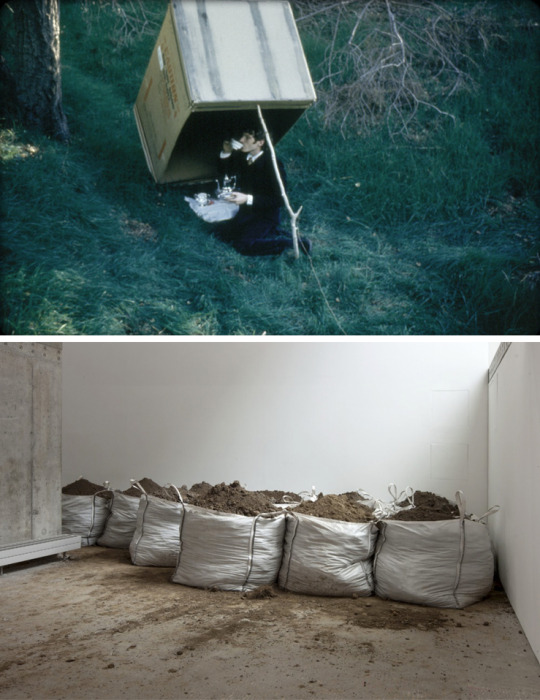
Top, Bas Jan Ader, still from Untitled (Teaparty), 1972. Via. Bottom, Santiago Sierra, 40 m3 of Earth from Iberian Peninsula, 2013. Installation view at KOW, Berlin. Via.
The 'falls' - a number of films and a series of photographic pieces - encapsulate the frailty and vulnerability at the heart of much of Ader's work. Fall (I Los Angeles) (1970), is a short film depicting the artist falling off a chair on the roof of his house and rolling down its slope to the ground. A second film, Fall (II Amsterdam) (1970), shows a view, shot across a canal, of the artist on a bicycle riding carefully down the street and then suddenly losing his balance and disappearing into the water with a large splash. Both films end abruptly after the moment of contact. Untitled (Teaparty) (1972) shares a similar sense of pointed conclusion. In a series of six colour photographs arranged in a column, the camera slowly zooms into a sunlit clearing in a wood where Ader, formally dressed, is taking afternoon tea - in the English style - under a large cardboard box propped up by a stick. The camera zooms out again and in the last frame the stick has come away and the box has fallen to capture the tea-drinker like a mouse in a trap. Via.
Sierra had 40 cubic meters of soil excavated on construction sites in Bilbao shipped to Berlin in plastic bags (known as “Big Bags”) measuring one by one by one meter and unloaded at KOW. The provenance of the material from the Spanish real-estate industry points to a shift of power in Europe’s economic structure. Some regions, such as the Iberian peninsula, find themselves devalued to the advantage of other regions or countries, especially Germany. New migration movements are set in motion, a phenomenon that the soil’s journey retraces. The distressed countries of Southern Europe now prepare their assets for shipping; they put their human capital and public property on the market at a discount and hand over control of systemically relevant infrastructures to investors. Packaged in Big Bags, the cheap containers of the shipping business, every cubic meter of Iberian soil represents the sell-out of someone’s living environment and self-determination and indeed of national sovereignty. Via.
--
The body is the being of existence. How best to take death seriously? But also: How are we to explain that existence isn't "for" death, but that "death" is the body of existence, a very different thing. There's no "death," taken as an essence to which we've been consigned: there's the body, the mortal spacing of the body, registering the fact that existence has no essence (not even "death"), but only ex-ists.
In the span of its lifetime, the body is also a dead body, the body of a dead person, this dead person I am when alive. Dead or alive, neither dead nor alive, I am the opening, the tomb or the mouth, the one inside the other.
Jean-Luc Nancy, Corpus (Trans. Richard A. Rand), 1992. Via.
1 note
·
View note
Text
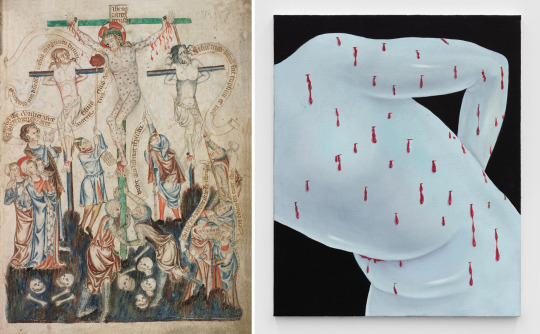
Left, a page from the Holkham Bible Picture Book, circa 1330, Jesus on the cross. Via. Right, Shuo Hao, La Torture, 2022, Oil on canvas, 73 × 60 cm. Via.
We know very little about the original purpose of this book, beyond that the events are given a contemporary, medieval setting: the English agricultural “Plough Monday” is believed to be referenced in a depiction of Cain; coif caps abound; and Roman guards wield weapons and don armor distinctly Middle Aged. The Bible may have been commissioned by a Dominican friar, for the manuscript begins, unusually, with a friar commanding his artist to “do it well and thoroughly, for it will be shown to important people”. While it is referred to as a Bible, the relationship between text and image throughout is atypical, as the words often serve to caption the events depicted, rather than reproduce sacred text. Throughout this trilingual manuscript, written mostly in Anglo-Norman, English plays a minor but important role. The language only appears when connected to shepherds. In a humorous and cryptic miniature (f. 13), the annunciation gets lost in translation: “Gloria in excelsis”, intones the angel, but the shepherds do not speak Latin. “Glum glo. . .”, attempts one man, in a sloppy and guttural imitation, before admitting that he’s babbling nonsense (“ceo ne est rien”). Via.
1 note
·
View note
Text
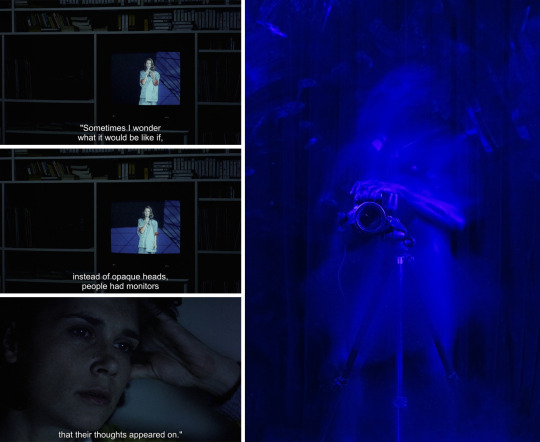
Left, screen captures from The Seventh Continent, directed by Michael Haneke, 1989. Via. Right, Paul Mpagi Sepuya, Blue Studio Mirror (0X5A8960), 2021, 40 x 60 inches.
--
On one of the higher benches, the bitcoin investor from Indiana started to explain to me why it was he wanted to earn money. He said he wanted to start an institute to study the origins of language.
He said that a student of René Girard—the French anthropologist who theorized mimetic desire and the scapegoat mechanism, whose work is beloved in Silicon Valley and aggressively promoted, in particular, by Peter Thiel—had applied his teacher’s findings to the fields of linguistics. He said that there was a professor at the university of Quinnipiac who was expounding this theory via a Substack with a modest following.
I asked if this institute’s findings would have political implications and he said that they would: “You’d agree that our leaders today are lacking, right? That there is something seriously wrong.”
“But if we know how language originated, how it really operates, we could start to cultivate better people—people who could really lead. The notion of leadership has really vanished from discourse today. People don’t want to discuss it.”
After talking for perhaps twenty minutes we went outside and jumped into an ice-cold pool. It was so cold that I could not feel my hands or feet. Then we went back into the sauna. Here I began to feel faint.
I asked the investor how the origins of language could be studied in the absence of material evidence. He replied, “It’s a good question. But every conversation carries the trace of an origin, so we can study how people talk today and learn something. And if you think about it, once this idea, the idea of this theory, is disseminated, every conversation going forward, from every person exposed to this idea of the origin of language, will contain the seed of that earlier conversation.”
Morley Musick, from Out of the Fog - In a way I was noticing it, and in a way I was just accepting what was happening to me, for n+1, April 1, 2024.
2 notes
·
View notes
Text

Fette Sans, Untitled (If I can’t sleep at night is it because I am [excluded]), 2019.
Performance. I hire Niza for one night and three afternoons to work the curtain door, only allowing cis-men to enter. No explanations are given, neither to the gallery who invited me to perform nor to the visitors, as to who gets in. A few *golden tickets* are offered, based only on Niza's feel for it, and others are eventually invited to cross the threshold. The vast majority of rejected people wait outside very compliant, while their partners or friends get to enter the other room. Upon return, most men explain to those rejected that there wasn't much to see inside, therefore they have not missed anything. A few men explain to those rejected, sometimes inquiring to Niza, that they must have missed the performance. Over the four days, only one man stepped back outside immediately upon realizing that the woman he had come to the gallery with had not made it in, realizing there were only men inside.
2 notes
·
View notes
Text
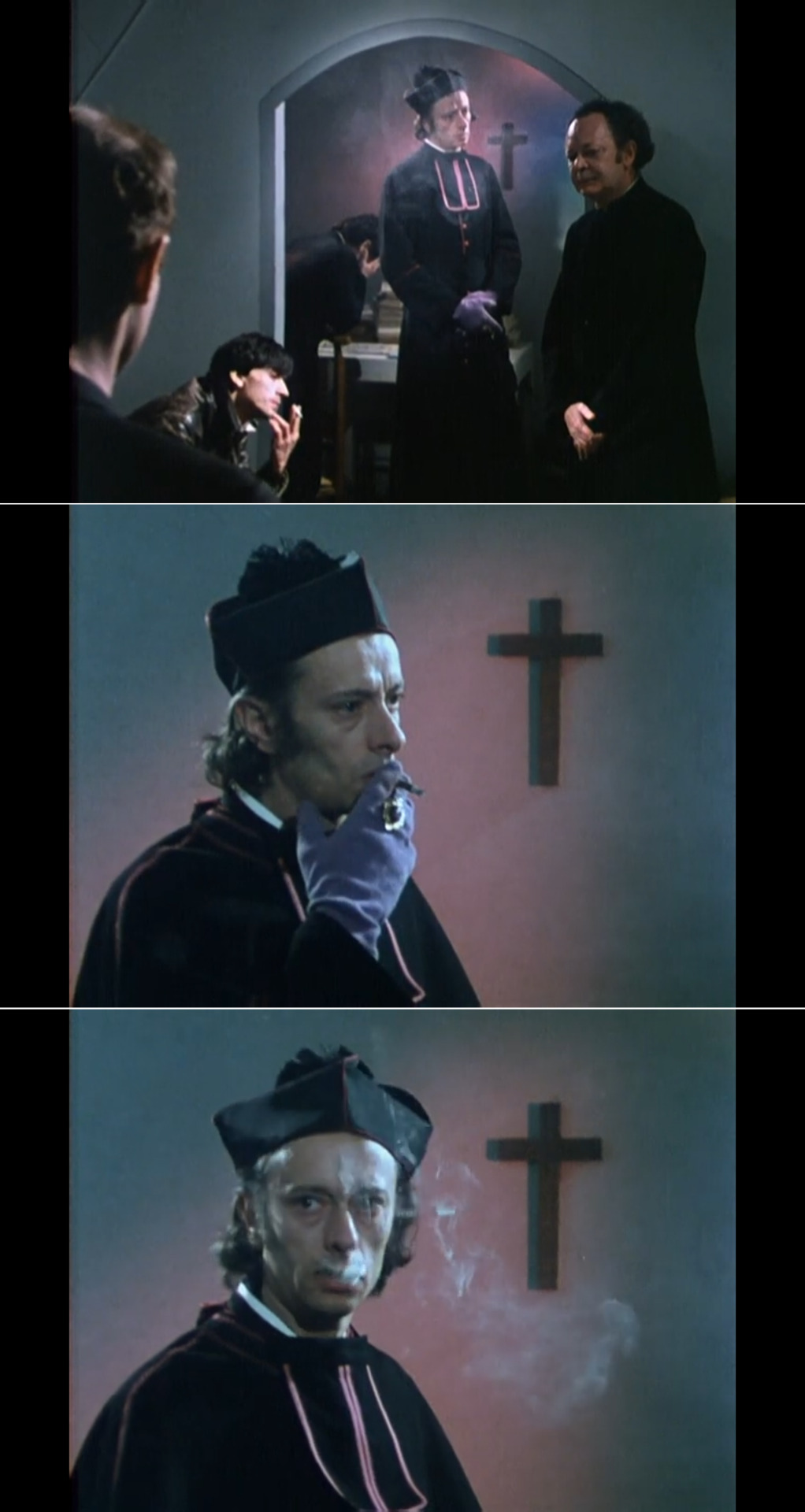
Screen captures from La vocation suspendue, directed by Raúl Ruiz, 1978.
--
Many transhumanists like (Ray) Kurzweil contend that they are carrying on the legacy of the Enlightenment — that theirs is a philosophy grounded in reason and empiricism, even if they do lapse occasionally into metaphysical language about “transcendence” and “eternal life.” As I read more about the movement, I learned that most transhumanists are atheists who, if they engage at all with monotheistic faith, defer to the familiar antagonisms between science and religion. Many regard Christianity in particular with hostility and argue that Christians are the greatest obstacle to the implementation of their ideas. In his novel, The Transhumanist Wager (2013), Zoltan Istvan, the founder of the Transhumanist political party, imagines Christians will be the ones to oppose the coming cybernetic revolution. Few Christians have shown much interest in transhumanism (or even awareness of it), but the religious right’s record of opposing stem-cell research and genetic engineering suggests it would resist technological modifications to the body. “The greatest threat to humanity’s continuing evolution,” writes transhumanist Simon Young, “is theistic opposition to Superbiology in the name of a belief system based on blind faith in the absence of evidence.” (...)
In the late 19th century, a Russian Orthodox ascetic named Nikolai Fedorov was inspired by Darwinism to argue that humans could direct their own evolution to bring about the resurrection. Up to this point, natural selection had been a random phenomenon, but now, thanks to technology, humans could intervene in this process. “Our body,” as he put it, “will be our business.” He suggested that the central task of humanity should be resurrecting everyone who had ever died. Calling on biblical prophecies, he wrote: “This day will be divine, awesome, but not miraculous, for resurrection will be a task not of miracle but of knowledge and common labor.” He speculated that technology could be harnessed to return Earth to its Edenic state. Space travel was also necessary, since as Earth became more and more populated by the resurrected dead, we would have to inhabit other planets.
Fedorov had ideas about how science could enact the resurrection, but the details were opaque. The universe, he mused, was full of “dust” that had been left behind by our ancestors, and one day scientists would be able to gather up this dust to reconstruct the departed. Another option he floated was hereditary resurrection: sons and daughters could use their bodies to resurrect their parents, and the parents, once reborn, could bring back their own parents. Despite the archaic wording, it’s difficult to ignore the prescience underlying these ideas. Ancestral “dust” anticipates the discovery of DNA. Hereditary resurrection prefigures genetic cloning.
This theory was carried into the 20th century by Pierre Teilhard de Chardin, a French Jesuit priest and paleontologist who, like Fedorov, believed that evolution would lead to the Kingdom of God. In 1949, Teilhard proposed that in the future all machines would be linked to a vast global network that would allow human minds to merge. Over time, this unification of consciousness would lead to an intelligence explosion — the Omega Point — enabling humanity to “break through the material framework of Time and Space” and merge seamlessly with the divine. The Omega Point is an obvious precursor to Kurzweil’s Singularity, but in Teilhard’s mind, it was how the biblical resurrection would take place. Christ was guiding evolution toward a state of glorification so that humanity could finally merge with God in eternal perfection. By this point, humans would no longer be human. Perhaps the priest had Dante in mind when he described these beings as “some sort of Trans-Human at the ultimate heart of things.”
Meghan O'Gieblyn, from Ghost in the Cloud - Transhumanism’s simulation theology, for n+1, Issue 28 : Half-Life, Spring 2017.
0 notes
Text

Top, Olbram Pavlíček, KORPSEPUNX@ABDOMEN-OF-THE-BEAST, 2023, mixed media, dimensions variable. Installation on view at Gallery of Modern Art in Hradec Králové, February 16 – May 26, 2024. Via. Bottom, screen capture from The Cremator, directed by Juraj Herz, 1969. Via.
--
"I always wanted to understand everything, both in a physical sense and in a more conceptual and intellectual sense," Zielinski told Hell Gate in a call from Woodbourne Correctional Facility, where he was sent in February of last year, after stints in other upstate prisons. "I want to take everything apart and see exactly how it works, because once you understand how things work, then you can use them to create even more new and interesting things."
That curiosity and interest in science partly explains why Zielinksi wants to be able to watch the rare total solar eclipse that is taking place on April 8, in spite of his incarceration. But earlier this month, New York’s Department of Corrections and Community Supervision (DOCCS) announced in a memo that they plan to institute a system-wide lockdown as a safety precaution during the eclipse.
In New York, the eclipse is a big deal: The path of totality sweeps across 29 counties in the state, offering a chance to catch a solar event that won't happen again for decades. Anticipating an influx of "millions of visitors," Governor Kathy Hochul recently announced that an Interagency Task Force has been meeting for the past 17 months to "ensure everyone can safely enjoy the eclipse." A DOCCS spokesperson confirmed that the department is part of this task force.
In January, Zielinski began a back and forth with prison staff at Woodbourne, asking that he be allowed to watch from the prison's main yard and be provided with eclipse glasses. Zielinski argued that the eclipse has special significance to atheists like himself, whose beliefs are grounded in a devotion to scientific discovery and achievement. In conversation with prison staff, Zielinski suggested the eclipse should be a facility-wide event open to all. Woodbourne's superintendent shot that idea down, Zielinksi told Hell Gate, but his personal request to mark the day as a religious event for his own observation was sent to DOCCS's central office.
Rebecca McCray, from Incarcerated New Yorkers Want to See the Eclipse. The State Has Responded With a Lockdown, for Hell Gate, March 28, 2024.
4 notes
·
View notes
Text
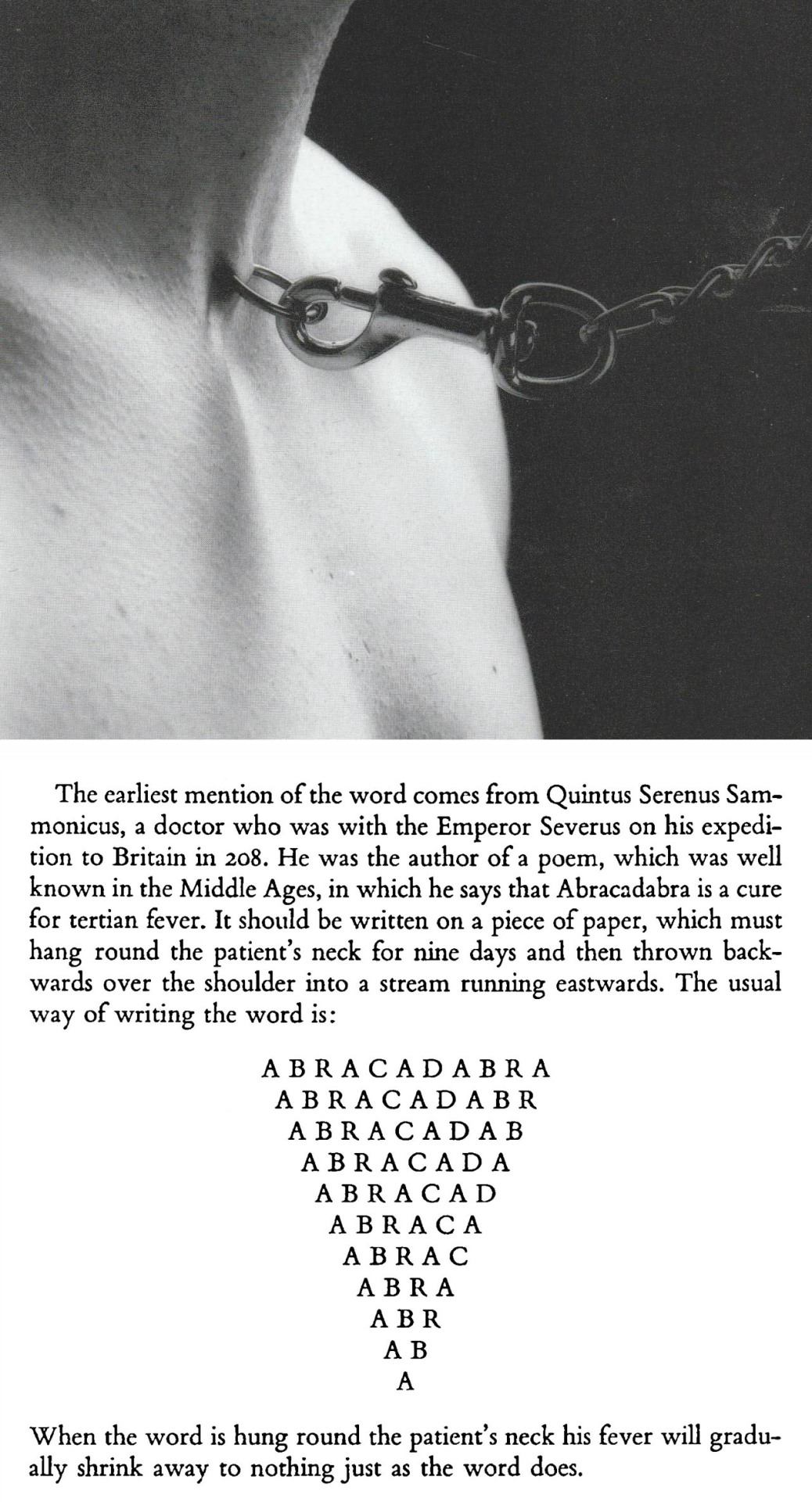
Top, photograph (scan) from Daniel H Uppendahl, from the series Corpus Transfixum, 1992-95. This image was also published in Fetish Photo Anthology Volume 2, 1997. Via. More. Bottom, page from Richard Cavendish, The Black Arts - A Concise History of Witchcraft, Demonology, Astrology, and Other Mystical Practices Throughout the Ages, 1967. Via.
2 notes
·
View notes
Text

Left, photograph by Mark Sommerfeld (I couldn't find a title nor a date). Via. Right, Manuel Cornelius, Stent, 2024 silicone, polyethylene terephthalate, tights, pigment, lacquer, 58 x 22 x 38 cm. Via.
--
If you’re born in a cubicle and grow up in a corridor, and work in a cell, and vacation in a crowded sun-room, then coming up into the open with nothing but sky over you might just give you a nervous breakdown.
Isaac Asimov, from Foundation, Volume 3, 1944. Via.
2 notes
·
View notes